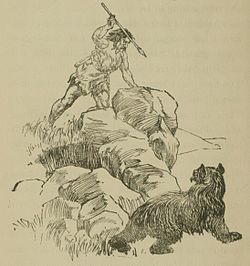
Caveman
About this schools Wikipedia selection
SOS believes education gives a better chance in life to children in the developing world too. A quick link for child sponsorship is http://www.sponsor-a-child.org.uk/
A caveman/woman or troglodyte is a stock character based upon widespread concepts of the way in which early prehistoric humans may have looked and behaved. The term caveman, sometimes used colloquially to refer to Neanderthal people, originates out of assumptions about the association between early humans and caves, most clearly demonstrated in cave painting or bench models.
Basis of Archetype
Caveman-like Heraldic " wild men" were found in European iconography for hundreds of years. During the Middle Ages, these creatures were generally depicted in art and literature as bearded and covered in hair, and often wielding clubs and dwelling in caves. While wild men were always depicted as living outside of civilization, there was an ongoing debate as to whether they were human or animal.
Cavemen are portrayed as wearing shaggy animal hides, armed with rocks or cattle bone clubs, unintelligent, and aggressive. Cavemen are often shown as living in caves, possibly because that is where the preponderance of ritual paintings and artifacts have been found. Although it is probable that Neanderthals and early humans lived elsewhere as well as in caves, artifacts proving this would have been destroyed over millennia, while that which had been left in caves survived to be discovered. Nevertheless, expressions such as "living in a cave" have become cultural metaphors for a modern human who supposedly displays traits of brutishness or extreme ignorance. See also troglodyte.
Stereotypes in culture
In Sir Arthur Conan Doyle's The Lost World (1912) ape-men are depicted in a fight with modern humans. Edgar Rice Burroughs adapted this idea for The Land That Time Forgot (1915). A genre of caveman movies emerged, typified by D. W. Griffith's Man's Genesis (1912); they inspired Charles Chaplin's satiric take, in His Prehistoric Past (1914) as well as Brute Force (1914), The Cave Man (1912), and later Cave Man (1934). From the descriptions, Griffith's characters can't talk, and use sticks and stones for weapons, while the hero of Cave Man is a Tarzan-like figure who fights dinosaurs.
Documentaries
- Walking with Cavemen
- Walking with Beasts
Caveman characters
- Alley Oop
- Anthro
- B.C.
- Captain Caveman
- Chuck Rock
- The Flintstones
- Gogs
- Land of the Lost (1974 TV series)
- Mightor
- Stig of the Dump
- The Resurrection of Jimber-Jaw
- Tor
- Trailer Park Boys Sam Losco is often referred to as a Caveman
- Unfrozen Caveman Lawyer, a Saturday Night Live sketch
- GEICO Cavemen
- Yahoo in Gulliver's Travels
- J. P. Manoux, plays Curtis the Caveman on the Disney show Phil of the Future
- Bob from Prometheus and Bob on KaBlam! on Nickelodeon
- Cave Guy, a villain on Freakazoid
- The Slag Brothers (Rock and Gravel) in Wacky Races
Movies
- His Prehistoric Past, 1914 Charlie Chaplin silent film
- Three Ages, 1923 Buster Keaton silent film
- Flying Elephants, 1928 Laurel and Hardy silent film
- One Million B.C., 1940
- Mysterious Island (half a dozen films)
- Teenage Caveman, 1958 Roger Corman film and 2002 TV series
- Eegah, 1962
- The Descent, 2005
- One Million Years B.C., 1966
- It's About Time (TV series 1966-67)
- When Dinosaurs Ruled the Earth, 1970
- Planet of Dinosaurs, 1971
- The Land That Time Forgot, 1975
- The People That Time Forgot, 1977
- Caveman, 1981
- History of the World, Part I, 1981
- Quest for Fire, 1981
- Luggage of the Gods!, 1983
- Iceman, 1984
- The Clan of the Cave Bear, 1986
- Encino Man, 1992
- The Flintstones, 1994
- Bikini Cavegirl, 2004
- 10,000 BC, 2008
- Year One, 2009
Novels
- The Village in the Treetops, 1901
- Quest for Fire, 1911
- The Cave Girl, 1913
- The Inheritors, 1955
- Dance of the Tiger, 1980
- Earth's Children series
- The Clan of the Cave Bear, 1980
- The Valley of Horses, 1982
- The Mammoth Hunters, 1985
- The Plains of Passage, 1990
- The Shelters of Stone, 2001
- Eden series
- West of Eden, 1984
- Winter in Eden, 1986
- Return to Eden, 1989

